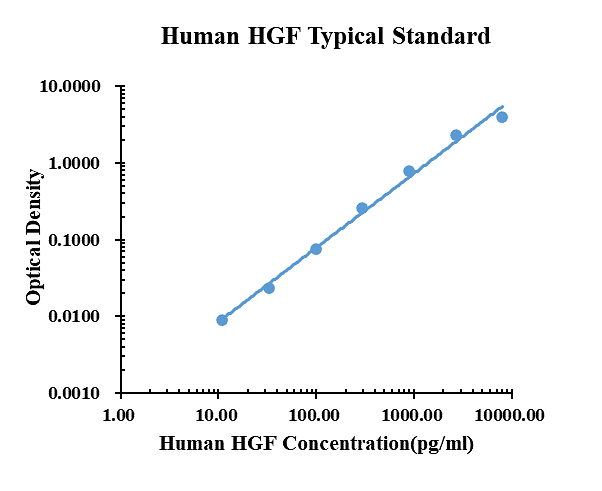Human HGF enzyme-linked immunoassay kit
| Specification | 96 Test |
|---|---|
| Sensitivity | 4.07 pg/ml (50 μl);6.01 pg/ml (10 μl) |
| Standard Curve Range | 10.97~8000 pg/ml |
| Standard Curve Gradient | 7 Points/3 Folds |
| Number of Incubations | 2 |
| Detectable sample | Liquid phase sample of soluble substances. For example: serum, plasma, cell culture supernatant, tissue grinding liquid, etc. |
| Sample Volume | 50 μl/10 μl |
| Type | Fully Ready-to-Use |
| Operation Duration | 120min |

| pg/ml | O.D. | Average | Corrected | |
|---|---|---|---|---|
| 0.00 | 0.0284 | 0.0277 | 0.0281 | |
| 10.97 | 0.0360 | 0.0382 | 0.0371 | 0.0091 |
| 32.92 | 0.0521 | 0.0501 | 0.0511 | 0.0231 |
| 98.77 | 0.1109 | 0.0958 | 0.1034 | 0.0753 |
| 296.30 | 0.2883 | 0.2774 | 0.2829 | 0.2548 |
| 888.89 | 0.8003 | 0.8033 | 0.8018 | 0.7738 |
| 2666.67 | 2.3398 | 2.3380 | 2.3389 | 2.3109 |
| 8000.00 | 3.9661 | 4.0435 | 4.0048 | 3.9768 |
Precision
| Intra-assay Precision | Inter-assay Precision | |||||
| Sample Number | S1 | S2 | S3 | S1 | S2 | S3 |
| 22 | 22 | 22 | 6 | 6 | 6 | |
| Average(pg/ml) | 190.1 | 1075.3 | 3244.1 | 214.2 | 1168.4 | 3780.4 |
| Standard Deviation | 12.4 | 73.9 | 219.8 | 15.2 | 69.0 | 144.5 |
| Coefficient of Variation(%) | 6.5 | 6.9 | 6.8 | 7.1 | 5.9 | 3.8 |
Intra-assay Precision (Precision within an assay) Three samples of known concentration were tested twenty times on one plate to assess intra-assay precision.
Inter-assay Precision (Precision between assays) Three samples of known concentration were tested six times on one plate to assess intra-assay precision.
Spike Recovery
The spike recovery was evaluated by spiking 3 levels of human HGF into health human serum sample. The un-spiked serum was used as blank in this experiment.
The recovery ranged from 88% to 121% with an overall mean recovery of 108%.
Sample Values
| Sample Matrix | Sample Evaluated | Range (pg/ml) | Detectable (%) | Mean of Detectable (pg/ml) |
|---|---|---|---|---|
| Serum | 30 | 360.14-1072.52 | 100 | 609.53 |
Serum/Plasma – Thirty samples from apparently healthy volunteers were evaluated for the presence of HGF in this assay. No medical histories were available for the donors.
Product Data Sheet
Background: HGF
HGF (Hepatocyte Growth Factor, Scatter Factor) induces the proliferation and migration of epithelial cells, hepatocytes, chondrocytes, keratinocytes, melanocytes, endothelial cells, and many tumor cells. During organogenesis and tissue repair, HGF promotes epithelial/endothelial morphogenesis by inducing cell scattering and branching tubulogenesis. It also supports insulin production by pancreatic beta cells, neuronal survival, and immune tolerance. HGF is secreted as a propeptide that is activated by uPA or HGF Activator at sites of tissue damage. Its signaling through the receptor HGF R/c-MET is enhanced by its prior binding to heparan sulfate proteoglycans. The serum levels of HGF are elevated in a wide range of pathologies including liver damage, acute kidney failure, myocardial infarction, type 1 diabetes, obesity, and cancer, as well as in the synovial fluid of rheumatoid arthritis patients.

